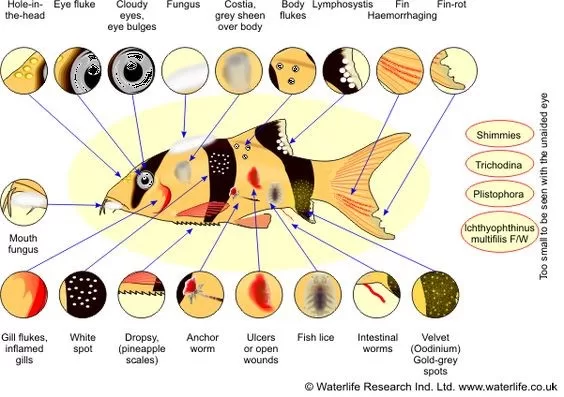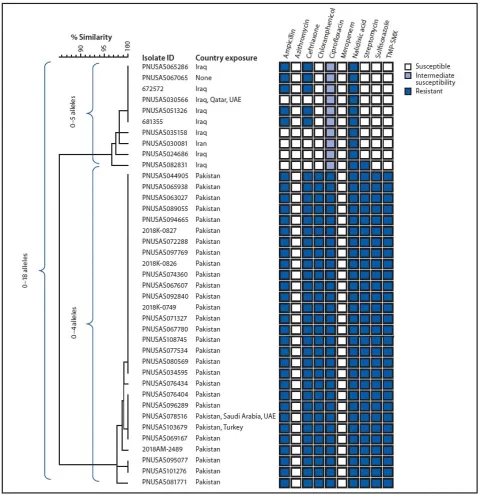Freshwater fish parasites have emerged as a significant concern for both aquatic life and human health, particularly in regions like California where fishing is a popular pastime. Recent studies have identified trematode infections, specifically from parasites like *Haplorchis pumilio* and *Centrocestus formosanus*, infecting an alarming number of freshwater fish species. These parasites thrive in ecosystems heavily impacted by invasive species, such as the freshwater snail *Melanoides tuberculata*, which can elevate the risks of fish consumption for the public. With a prevalence of up to 93% in certain fish populations, awareness and understanding of how these fish parasites operate are crucial for safety. As more people consume freshwater fish, it’s essential to recognize the importance of cooking these fish properly to mitigate potential health risks associated with these parasites.
The presence of harmful organisms in freshwater fish, commonly referred to as fish-borne parasites, is becoming a critical health issue. Various species of flatworms, including prevalent trematodes, can infect the fish that people commonly catch and eat. As urban fishing grows in popularity, the potential health implications linked to consuming infected fish are a rising concern, particularly from species introduced to North America through invasive aquatic snails. These organisms can pose gastrointestinal risks to those who consume them raw or undercooked, making public awareness and education on safe fish consumption practices all the more vital. Understanding the implications of these parasites not only helps protect individual health but also underscores the importance of monitoring environmental changes and their effects on freshwater ecosystems.
Understanding Freshwater Fish Parasites in California
Freshwater fish parasites pose a significant concern for anglers and consumers in California due to the prevalence of trematodes in local fish populations. Recent studies have indicated that two specific species, *Haplorchis pumilio* and *Centrocestus formosanus*, have established themselves in several freshwater species, leading to concerns about the health risks associated with consuming infected fish. With the growing popularity of fishing in California, awareness of these parasites is crucial for both recreational fishers and public health officials.
The discovery of trematodes in commonly caught fish such as largemouth bass, bluegill, and black crappie highlights the need for consumers to be informed about the risks involved in eating freshwater fish. These parasites are not only infecting fish but can also have implications for human health when ingested. As research continues to unfold, understanding the life cycle and transmission of these parasites becomes increasingly essential for maintaining safe fishing practices.
Impact of Trematode Infections on Fish and Human Health
Trematode infections in freshwater fish, particularly species like *Haplorchis pumilio* and *Centrocestus formosanus*, have a significant impact on the health of fish populations. These parasites thrive in conditions facilitated by the invasion of the freshwater snail *Melanoides tuberculata*, which acts as a host for the trematodes. The widespread infection of fish can lead to population declines, potentially affecting the biodiversity of aquatic ecosystems in California. Importantly, this increase in parasite prevalence can also threaten human health, especially for those who consume undercooked or raw fish.
Even though no human cases have yet been officially reported, the transmission risk remains plausible, particularly in regions with high fishing activity. Ingestion of trematodes can result in gastrointestinal disturbances ranging from mild diarrhea to severe symptoms such as weight loss and lethargy. The public must be educated on the importance of proper cooking and freezing techniques to eliminate these parasites, thereby minimizing health risks associated with fish consumption.
The Role of Invasive Species in Parasite Transmission
Invasive species, such as the freshwater snail *Melanoides tuberculata*, play a crucial role in the life cycle of trematode parasites that affect freshwater fish in California. The arrival of this snail species more than a decade ago has changed the dynamics of local ecosystems, allowing previously rare parasites to infect a range of freshwater fish. The presence of these invasive snails in 17 states, including California, has raised alarms as they can facilitate the transmission and increase the prevalence of trematode infections in fish populations that anglers commonly catch.
This phenomenon underlines the critical intersection of environmental health and public health. Fisheries managers and researchers must address the challenges posed by invasive species to prevent the spread of fish-borne parasites. Effective management strategies and public awareness campaigns are vital to reducing the risks of fish consumption and ensuring healthier aquatic ecosystems, ultimately safeguarding both environmental and human health.
Risks Associated with Consuming Infected Fish
The consumption of freshwater fish infected with trematodes such as *Haplorchis pumilio* and *Centrocestus formosanus* carries significant health risks. Anglers and consumers should be particularly cautious about their cooking methods, as consuming raw or undercooked fish could lead to infections. A review of various social media videos revealed a concerning trend; many depicted the preparation and consumption of raw fish, highlighting the urgent need for public health initiatives that educate about the risks associated with raw fish consumption.
With over 5 million views on such videos, it is evident that the practice is popular among many fish enthusiasts. While no confirmed human cases have been reported thus far, the expectation is that effective education on the proper cooking and freezing of fish is crucial. Public health officials must work diligently to inform communities about the symptoms of trematode infections and promote safe consumption practices, which can greatly reduce the associated health risks.
Mitigating the Risks of Fish Consumption
To mitigate the risks associated with consuming infected freshwater fish in California, public education is key. Consumers should be aware of the potential presence of parasites like *Haplorchis pumilio* and *Centrocestus formosanus* in local fish. Recommended safety measures include thoroughly cooking fish to an internal temperature that kills parasites, or freezing fish for a minimum period that also eliminates the risk of infection. These measures are crucial for preventing gastrointestinal diseases that can stem from eating infected fish.
Efforts from both health authorities and environmental organizations should focus on raising awareness among fishermen and the general public about the importance of safe fish harvesting and preparation practices. By combining education with regulatory measures surrounding the fishing industry, California can better ensure the health and safety of those consuming freshwater fish in the region.
The Importance of Research in Understanding Fish-Borne Diseases
Ongoing research is essential in understanding the dynamic relationship between freshwater fish parasites and human health. As more studies identify the prevalence and transmission pathways of trematodes like *Haplorchis pumilio* and *Centrocestus formosanus*, they provide vital data for public health guidelines. Researchers from institutions like the Scripps Institution of Oceanography are paving the way in revealing the risks associated with fish consumption, particularly in highly trafficked fishing areas in California.
By investigating the ecology of these parasites and their hosts, researchers can help inform public health strategies aimed at educating consumers about safe practices. Their findings can also guide policies aimed at environmental management and help mitigate the invasion of species that contribute to the health risks associated with consuming freshwater fish.
Conclusions on Freshwater Fish Parasites and Public Health
In conclusion, the emergence of freshwater fish parasites such as *Haplorchis pumilio* and *Centrocestus formosanus* in California is a growing public health concern that requires immediate attention. The interconnection between invasive species and increased prevalence of these parasites emphasizes the need for regulatory intervention and public education regarding safe fish consumption practices. As anglers continue to enjoy fishing in local waters, awareness of the potential risks should be at the forefront.
Ensuring the public understands the dangers of consuming raw or undercooked fish affected by trematodes will be pivotal in decreasing infection rates. Public health strategies must be complemented by ongoing research efforts that further uncover the complexities of parasite transmission in freshwater ecosystems. Only through collaborative efforts can California preserve both its natural resources and public health.
Future Directions for Managing Fish-Borne Parasite Risks
Looking ahead, it is crucial for California to implement comprehensive management strategies addressing the risks posed by freshwater fish parasites. This includes monitoring invasive species like *Melanoides tuberculata*, as their presence significantly contributes to the spread of trematode infections among fish populations. Enhanced testing and surveillance protocols at popular fishing sites could provide early detection of parasites, allowing for timely public health advisories.
Moreover, educational programs targeting anglers can promote safe fishing practices and raise awareness of the risks associated with fish consumption. Collaboration between environmental agencies and public health departments will be vital in developing policies that balance ecological preservation with community health needs. Proactive measures taken today can have lasting impacts on the health of both fish populations and human consumers in the years to come.
Frequently Asked Questions
What types of freshwater fish parasites are found in California?
In California, two notable species of freshwater fish parasites, *Haplorchis pumilio* and *Centrocestus formosanus*, are prevalent among various freshwater fish species. These trematodes, or flatworms, are associated with common fish like largemouth bass and bluegill.
How do trematode infections impact freshwater fish in California?
Trematode infections caused by parasites like *Haplorchis pumilio* and *Centrocestus formosanus* significantly impact freshwater fish in California. These infections can lead to health issues in fish and pose a transmission risk to humans who consume these infected fish.
What are the risks of fish consumption regarding freshwater fish parasites?
The risks of fish consumption related to freshwater fish parasites, particularly *Haplorchis pumilio* and *Centrocestus formosanus*, include gastrointestinal symptoms in humans if raw or undercooked fish are ingested. Public health officials recommend proper cooking or freezing of fish to mitigate these risks.
How can I prevent infection from freshwater fish parasites when eating fish?
To prevent infection from freshwater fish parasites like *Haplorchis pumilio* and *Centrocestus formosanus*, ensure fish are thoroughly cooked or frozen before consumption. This process kills the parasites and reduces the risk of trematode infections.
What is the role of snails in the lifecycle of freshwater fish parasites?
In the lifecycle of freshwater fish parasites such as *Haplorchis pumilio*, snails, particularly *Melanoides tuberculata*, act as intermediate hosts. The parasites infect the snails before they exit and infect fish, which can lead to transmission to humans through consumption.
Are there any reported human cases of trematode infections from freshwater fish in the U.S.?
Currently, there have been no reported human cases of trematode infections from freshwater fish in the U.S. However, researchers emphasize the potential for local transmission, highlighting the importance of awareness and preventive measures.
Why should I be concerned about freshwater fish parasites like Haplorchis pumilio and Centrocestus formosanus?
Concerns about freshwater fish parasites like *Haplorchis pumilio* and *Centrocestus formosanus* stem from their prevalence in common fish species and the potential risks they pose to human health through consumption of infected fish.
How prevalent are trematode infections in freshwater fish in California fishing sites?
Trematode infections in freshwater fish at California fishing sites are notably high, with *Haplorchis pumilio* found in 93% of analyzed fish across multiple locations, indicating a significant public health concern.
| Key Points |
|---|
| Freshwater fish in California are infected with two types of fish-borne parasites: *Haplorchis pumilio* and *Centrocestus formosanus*. |
| Researchers found a 93% prevalence of *Haplorchis pumilio* in seven fish species and an 89% prevalence of *Centrocestus formosanus* in certain locations. |
| Common infected fish species include largemouth bass, bluegill, black crappie, and common carp. |
| The invasive snail *Melanoides tuberculata* is a host for these parasites, contributing to their spread. |
| Most infections occur from consuming raw or undercooked fish, with 65% of analyzed videos showing this risky consumption behavior. |
| While no human cases have been reported, health officials are urged to raise awareness of trematode infection risks. |
Summary
Freshwater fish parasites are emerging as a potential risk for public health in California, as new research reveals high infection rates among commonly consumed freshwater fish. The presence of trematodes like *Haplorchis pumilio* and *Centrocestus formosanus* has been linked to an invasive snail, raising concerns about transmission through the consumption of uncooked fish. Although no human infections have been confirmed yet, the findings highlight the importance of public awareness and safe fish preparation practices to mitigate the risk of parasitic infections.
The content provided on this blog (e.g., symptom descriptions, health tips, or general advice) is for informational purposes only and is not a substitute for professional medical advice, diagnosis, or treatment. Always seek the guidance of your physician or other qualified healthcare provider with any questions you may have regarding a medical condition. Never disregard professional medical advice or delay seeking it because of something you have read on this website. If you believe you may have a medical emergency, call your doctor or emergency services immediately. Reliance on any information provided by this blog is solely at your own risk.








